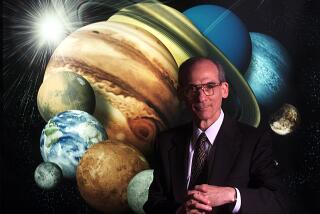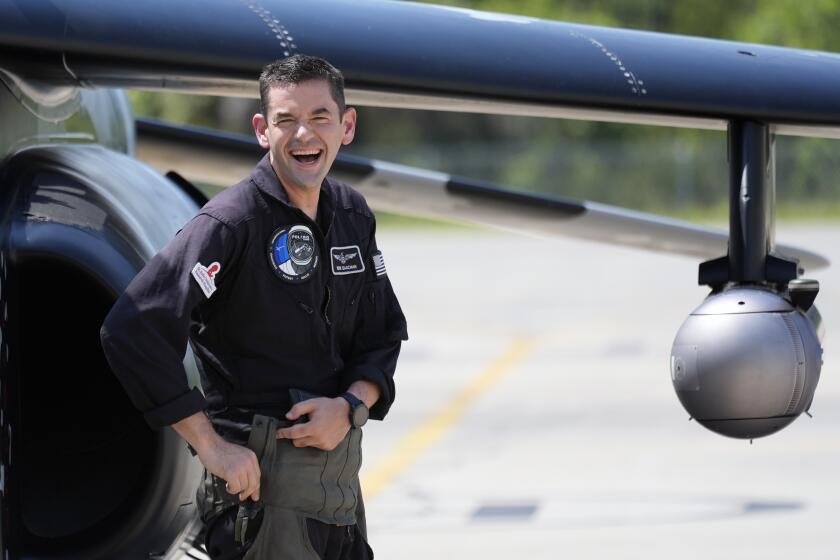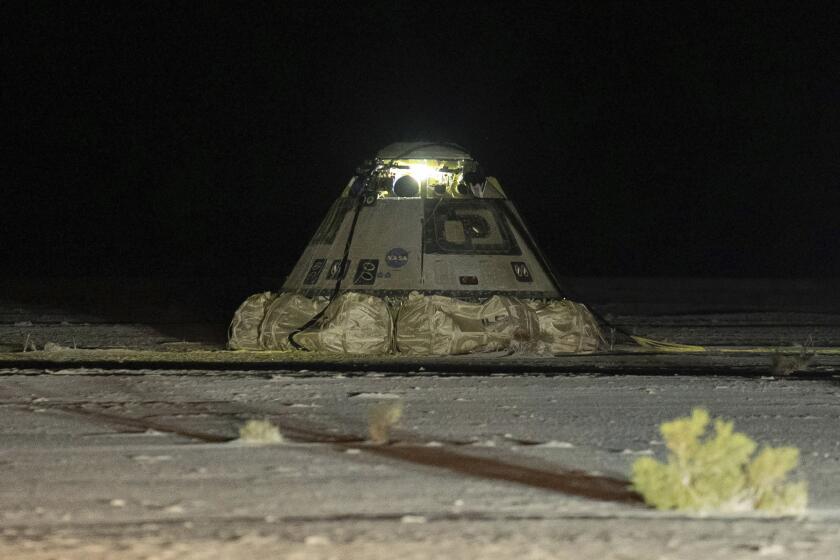Dick Rutan, co-pilot of around-the-world flight, dies at 85
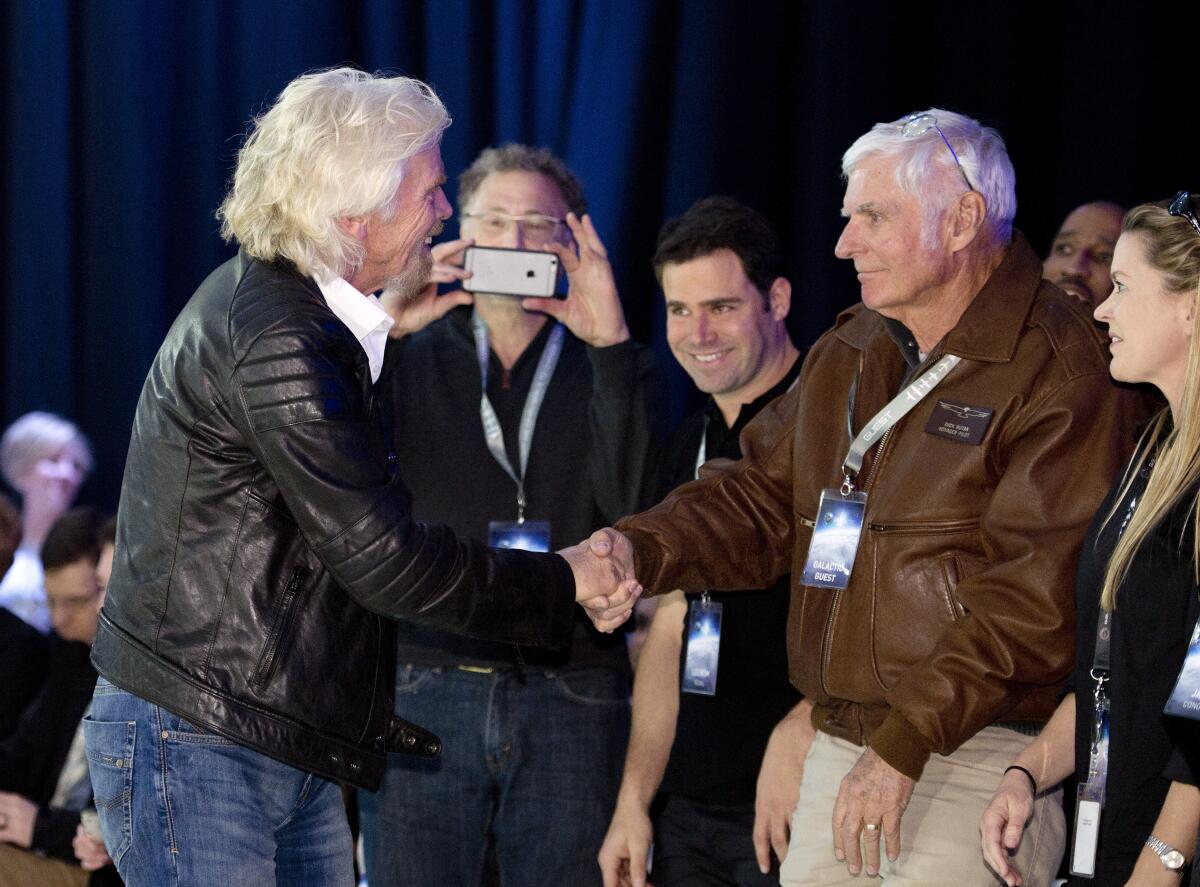
Even as a young child growing up in the small Central Valley town of Dinuba, Dick Rutan knew that he wanted to be a pilot. Whenever he heard an airplane, he would gaze up and it seemed the sky was beckoning him.
“I wanted to get up there in it,” Rutan recalled. “Those contrails of the big jets overwhelmed me. It was my destiny to fly.”
He started lessons at 15, soloed on his 16th birthday and had a flight instructor’s rating by the time he graduated high school. He would go on to fly more than 300 combat missions in Vietnam, but those were the least of his achievements.
Five people aboard a Russian-designed biplane were stranded Monday when the plane landed at the North Pole and sank through the ice.
In 1986, the decorated airman co-piloted the experimental aircraft Voyager around the world in nine days, taking off from and landing at Edwards Air Force Base in the Mojave Desert without stopping or refueling — one of aviation’s greatest milestones.
“It’s a grand adventure,” a wobbly Rutan said, after the nationally televised landing watched by President Reagan.
Rutan died Friday at a hospital in Coeur d’Alene, Idaho, after suffering from a lung infection. His brother Burt Rutan, an aerospace engineer who designed the spindly Voyager, was at his bedside. Rutan was 85.
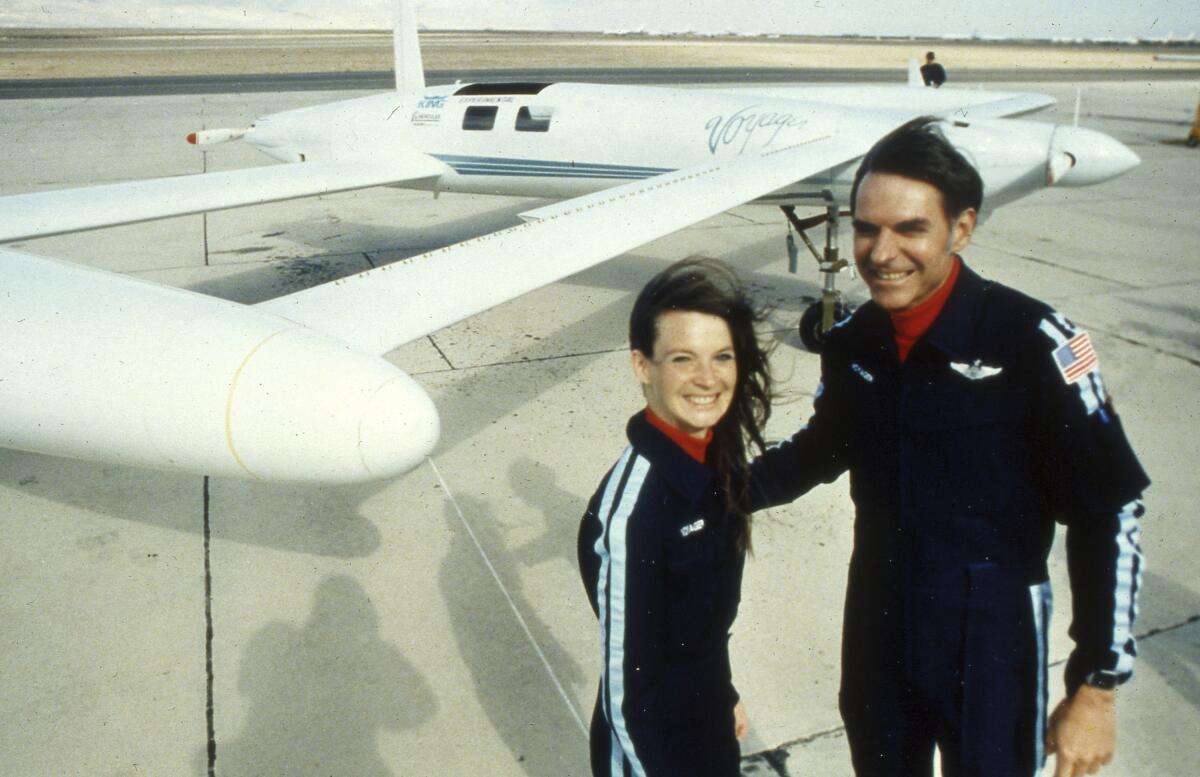
After 20 years in the Air Force, Dick Rutan joined his younger brother’s Mojave aircraft company as a production manager and chief test pilot, but resigned to found Voyager Aircraft Co. with a single goal in mind: completing the record-breaking flight.
Dick Rutan, co-pilot of the Voyager, is at home in the air.
The round-the-world trip was the product of six years of planning, development and testing, supported by grassroots donations when Rutan and his co-pilot, Jeana Yeager, his girlfriend at the time, could not strike a deal for a corporate sponsorship. (Yeager is no relation to famed test pilot Chuck Yeager.)
The twin-engine Voyager was constructed out of a lightweight graphite-honeycomb composite. It had a small cabin and disproportionate wingspan of nearly 111 feet that enabled it to carry more than four times its weight in fuel — 1,500 gallons tipping the scales at nearly 9,000 pounds — making it uncomfortable to sleep in and ungainly to fly.
It took off from Edwards at 8:02 a.m. on Dec. 14, a Sunday, and barely got off the ground, as the tips of its fuel-laden wings scraped the runway. During the trip, Rutan and Yeager traded piloting duties as the other attempted to sleep. Along the way, they battled tropical storms and averted disaster when an engine cut out just 450 miles from home. They were able to restart it.
When they landed 24,986 miles later, thousands cheered, and both pilots were some 10 pounds lighter. They, along with Burt Rutan, would meet the president, who awarded each the Presidential Citizens Medal. The Voyager was chosen by the Smithsonian National Air and Space Museum in Washington for inclusion in its collection of historic aircraft.
“He played an airplane like someone plays a grand piano,” said Burt Rutan of his brother.
Dick Rutan achieved celebrity and was in demand on the speaker circuit but didn’t gain the fortune he had expected after scrimping for years to get Voyager aloft. (His brother would go on to design SpaceShipOne, the first privately funded and crewed craft to enter space, launching an entirely new industry.)
In 1992, Rutan ran for Congress against Democratic Rep. George Brown Jr. in California’s 42nd Congressional District in the Inland Empire. A surprise winner of the Republican primary, Rutan was beaten in the general election.
The pilot never lost his taste for pushing aviation’s limits. In 1998, when he was 59, he and a co-pilot attempted to become the first balloonists to fly nonstop around the world. But the duo had to bail out and parachute to safety when the craft sprang a helium leak shortly after takeoff in New Mexico.
Rutan shrugged it off, noting he had had to bail out of planes twice before, including once in Vietnam when his jet was shot out of the sky. (The global circumnavigation was achieved the next year by a pair of Swiss and British balloonists.)
Not one to turn down an adventure, he got stranded in the North Pole for several days two years later when the Russian biplane carrying him and four others landed and partially sank through the ice. He wasn’t seeking a record but just wanted to check out the pole.
Rutan set another aviation record in 2005 when, in his 60s, he flew some 10 miles in a rocket-powered plane launched from the ground.
Greg Morris, president of Scaled Composites, a Mojave aerospace company founded by Burt Rutan, said when he was about 7 he met the aviation pioneer and over the years always found him generous and welcoming.
“Bigger than life, in every sense of the word,” Morris said, noting Rutan’s legacy with Voyager, as a test pilot and in the military, where he earned a Silver Star, five Distinguished Flying Crosses, 16 Air Medals and a Purple Heart. “Any one of those contributions would make a legend in aviation. All of them together, in one person, is just inconceivable.”
Born July 1, 1938, in Loma Linda, Rutan is survived by his wife of 25 years, Kris Rutan; daughters Holly Hogan and Jill Hoffman, from a previous marriage; and grandchildren Jack, Sean, Noelle and Haley.
The Associated Press contributed to this report.
More to Read
Inside the business of entertainment
The Wide Shot brings you news, analysis and insights on everything from streaming wars to production — and what it all means for the future.
You may occasionally receive promotional content from the Los Angeles Times.
